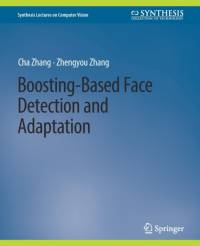Boosting-Based Face Detection and Adaptation
- Indbinding:
- Paperback
- Sideantal:
- 144
- Udgivet:
- 20. september 2010
- Størrelse:
- 191x9x235 mm.
- Vægt:
- 284 g.
- 2-4 uger.
- 16. maj 2025
På lager
Normalpris
Abonnementspris
- Rabat på køb af fysiske bøger
- 1 valgfrit digitalt ugeblad
- 20 timers lytning og læsning
- Adgang til 70.000+ titler
- Ingen binding
Abonnementet koster 75 kr./md.
Ingen binding og kan opsiges når som helst.
- 1 valgfrit digitalt ugeblad
- 20 timers lytning og læsning
- Adgang til 70.000+ titler
- Ingen binding
Abonnementet koster 75 kr./md.
Ingen binding og kan opsiges når som helst.
Beskrivelse af Boosting-Based Face Detection and Adaptation
Face detection, because of its vast array of applications, is one of the most active research areas in computer vision. In this book, we review various approaches to face detection developed in the past decade, with more emphasis on boosting-based learning algorithms. We then present a series of algorithms that are empowered by the statistical view of boosting and the concept of multiple instance learning. We start by describing a boosting learning framework that is capable to handle billions of training examples. It differs from traditional bootstrapping schemes in that no intermediate thresholds need to be set during training, yet the total number of negative examples used for feature selection remains constant and focused (on the poor performing ones). A multiple instance pruning scheme is then adopted to set the intermediate thresholds after boosting learning. This algorithm generates detectors that are both fast and accurate. We then present two multiple instance learning schemesfor face detection, multiple instance learning boosting (MILBoost) and winner-take-all multiple category boosting (WTA-McBoost). MILBoost addresses the uncertainty in accurately pinpointing the location of the object being detected, while WTA-McBoost addresses the uncertainty in determining the most appropriate subcategory label for multiview object detection. Both schemes can resolve the ambiguity of the labeling process and reduce outliers during training, which leads to improved detector performances. In many applications, a detector trained with generic data sets may not perform optimally in a new environment. We propose detection adaption, which is a promising solution for this problem. We present an adaptation scheme based on the Taylor expansion of the boosting learning objective function, and we propose to store the second order statistics of the generic training data for future adaptation. We show that with a small amount of labeled data in the new environment, the detector'sperformance can be greatly improved. We also present two interesting applications where boosting learning was applied successfully. The first application is face verification for filtering and ranking image/video search results on celebrities. We present boosted multi-task learning (MTL), yet another boosting learning algorithm that extends MILBoost with a graphical model. Since the available number of training images for each celebrity may be limited, learning individual classifiers for each person may cause overfitting. MTL jointly learns classifiers for multiple people by sharing a few boosting classifiers in order to avoid overfitting. The second application addresses the need of speaker detection in conference rooms. The goal is to find who is speaking, given a microphone array and a panoramic video of the room. We show that by combining audio and visual features in a boosting framework, we can determine the speaker's position very accurately. Finally, we offer our thoughts on future directions for face detection. Table of Contents: A Brief Survey of the Face Detection Literature / Cascade-based Real-Time Face Detection / Multiple Instance Learning for Face Detection / Detector Adaptation / Other Applications / Conclusions and Future Work
Brugerbedømmelser af Boosting-Based Face Detection and Adaptation
Giv din bedømmelse
For at bedømme denne bog, skal du være logget ind.
Find lignende bøger
Bogen Boosting-Based Face Detection and Adaptation findes i følgende kategorier:



